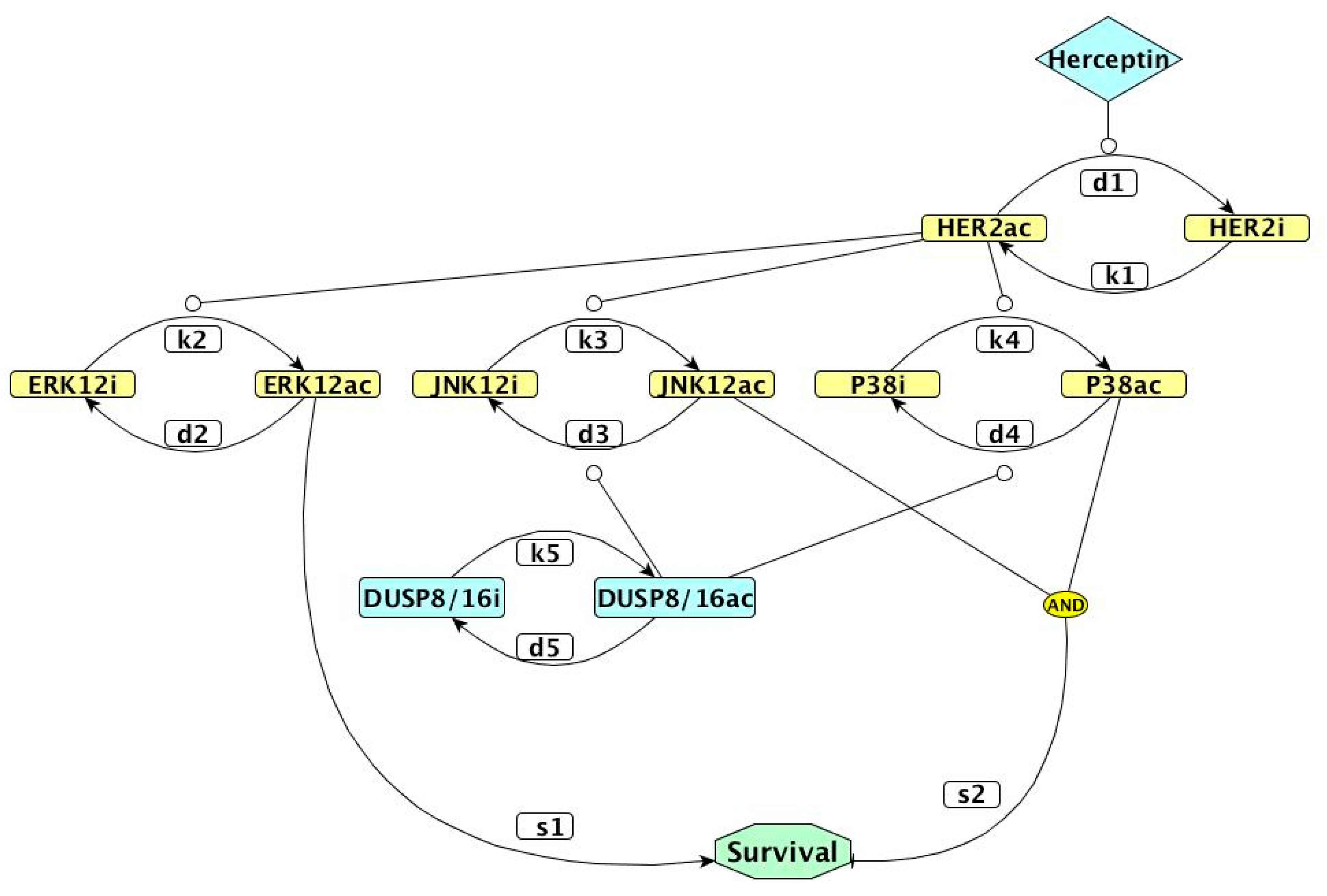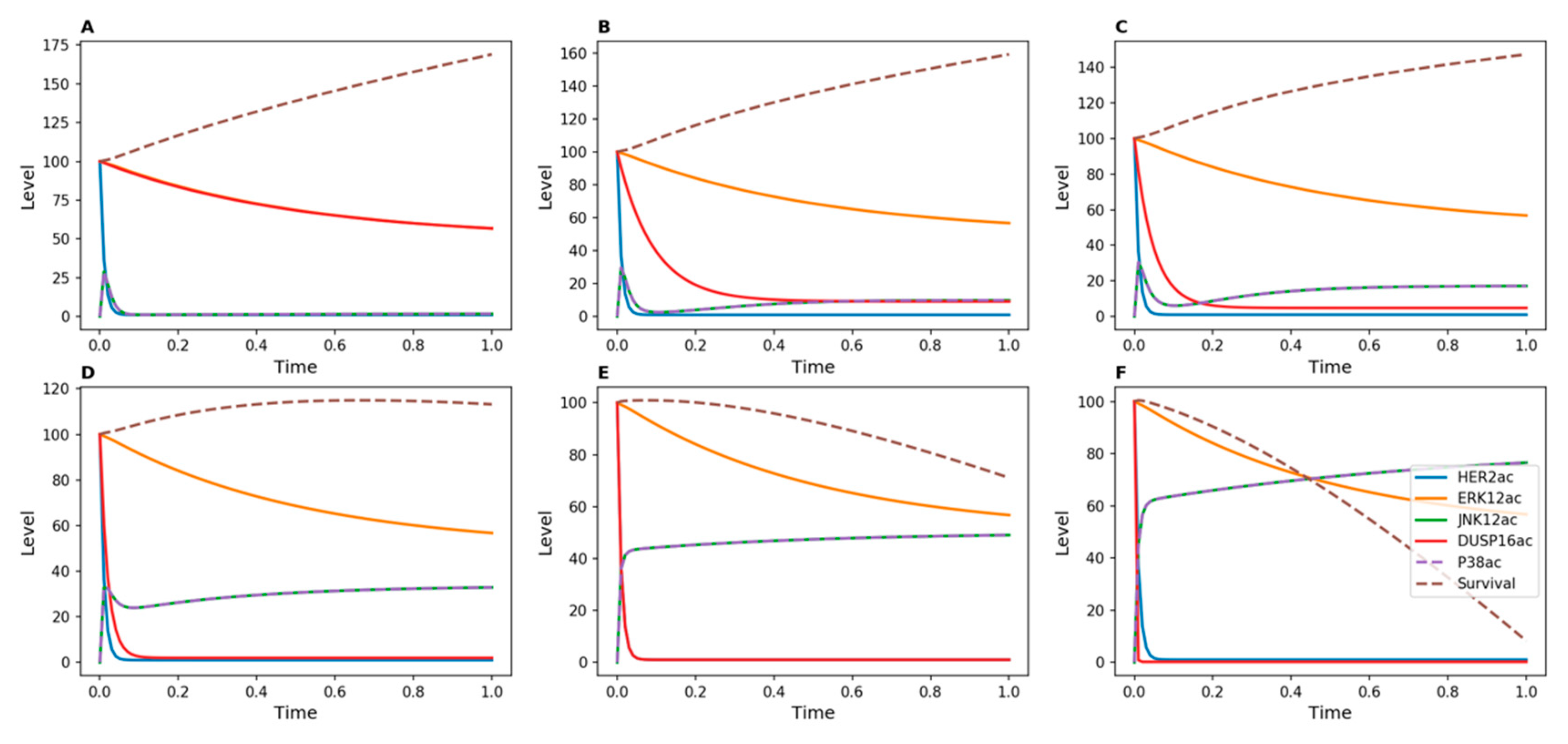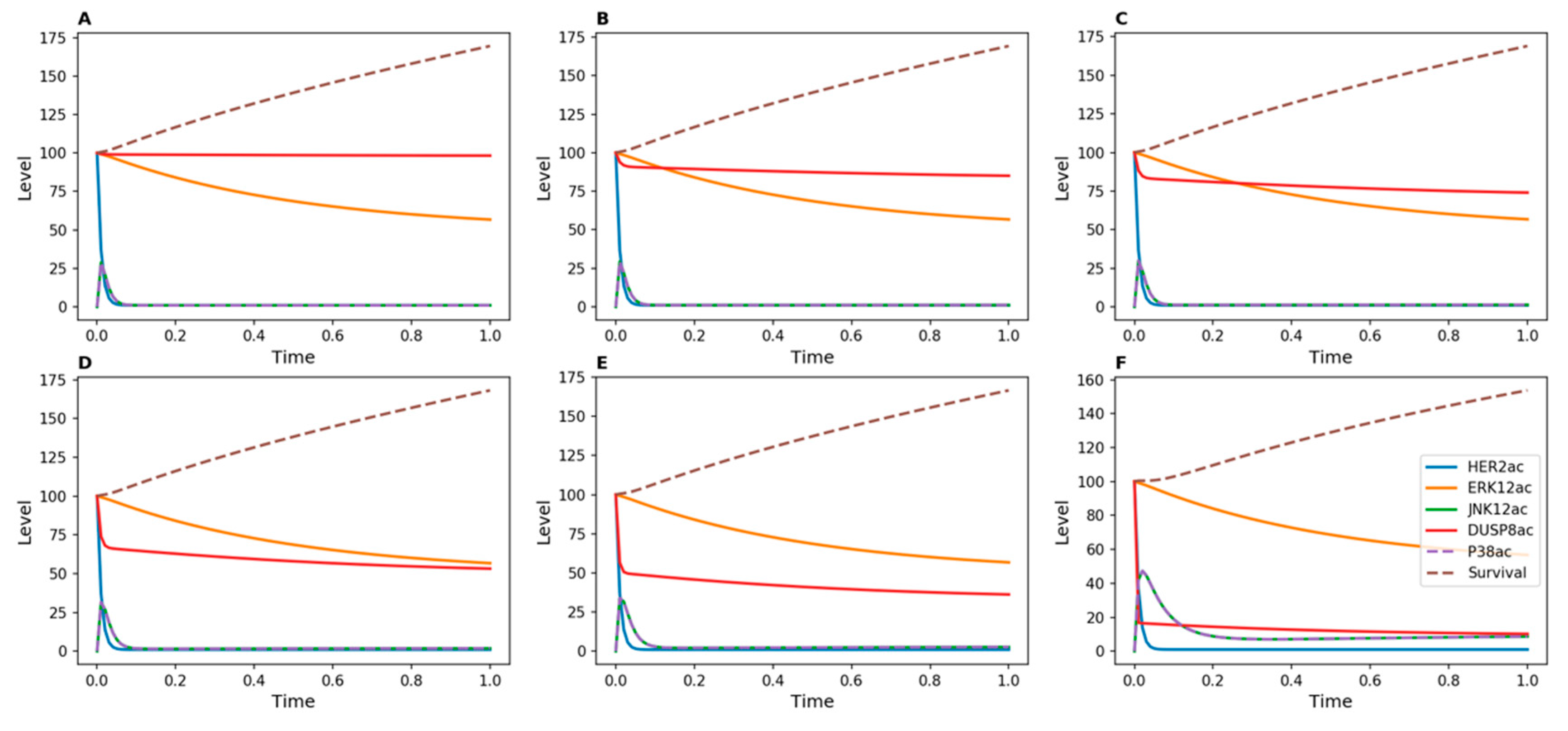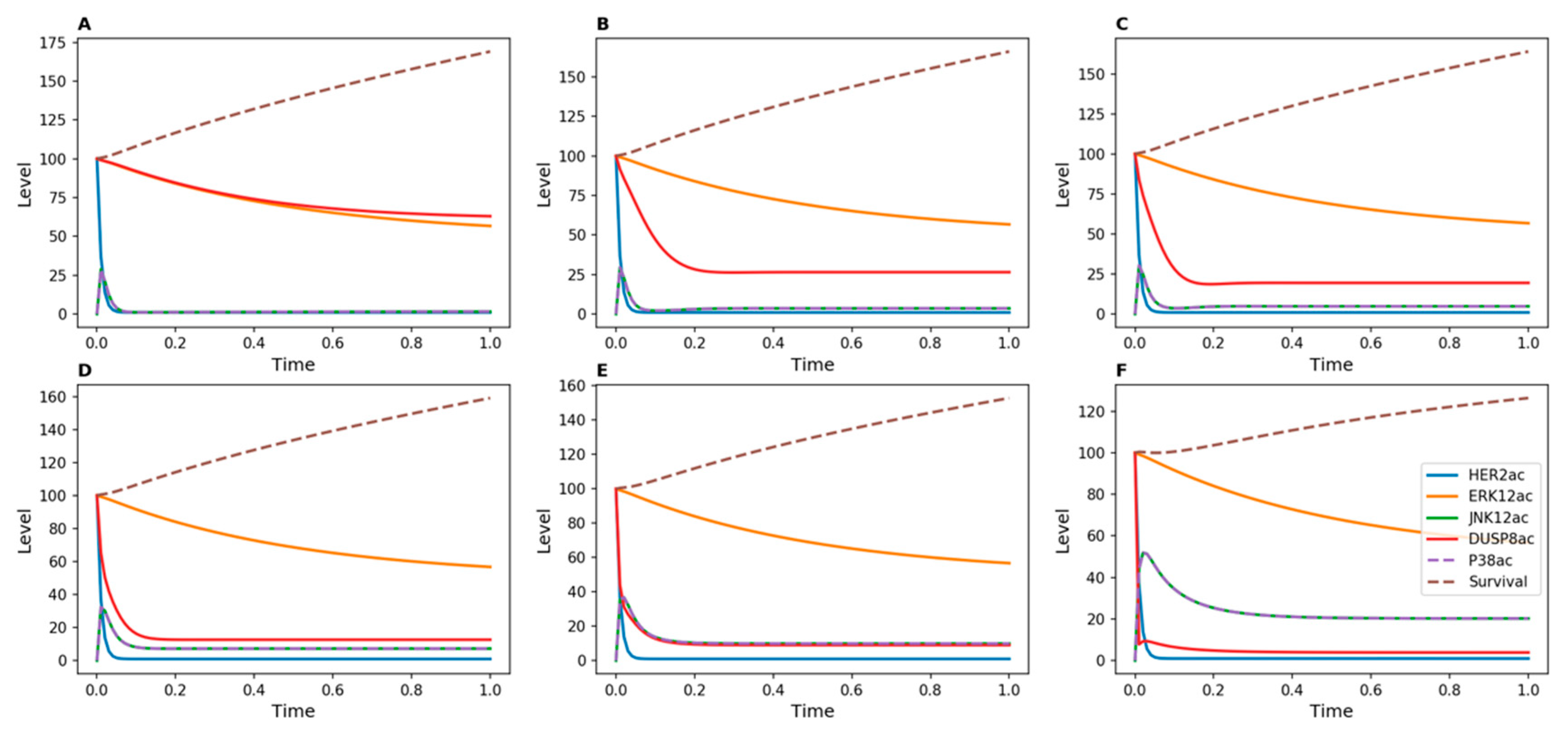1. Introduction
Breast cancer is a global burden for women’s health that affects one in eight women during their lifetime. The disease typically arises from disruptions to integrated signaling networks in mammary epithelial cells, in which one or more proteins are dis-regulated. The exact mechanisms affected are diverse, and vary among the several breast cancer sub-types. In particular, HER2 (human epidermal growth factor 2)-positive breast cancer is characterized by the overexpression of the receptor-type protein tyrosine kinase HER2 or amplification of the
HER2 gene [
1,
2,
3]. Herceptin (trastuzumab) is a humanized monoclonal antibody that binds to the extracellular domain of HER2 and down-regulates its function, thereby inhibiting tumor cell growth. Herceptin has been suggested to act by promoting HER2 degradation, by inducing antibody-dependent cellular toxicity against the tumor cells that it binds, and by inhibiting downstream signaling pathways such as MAP (mitogen-activated protein) kinases and PI3K (phosphatidylinositol 3 kinase) [
4]. Herceptin is widely used for the treatment of HER2-positive breast cancer, but resistance to its action frequently develops and limits its therapeutic benefit [
5]. Extracellularly regulated kinases 1 and 2 (ERK1/2), p38, and c-Jun N-terminal kinases 1 and 2 (JNK1/2) act downstream of HER2 [
6] and are key players in regulating cell proliferation. Hence, understanding their role in the development of resistance to HER2 is essential. These kinases are activated by the phosphorylation of conserved and neighboring threonine and tyrosine residues, and can be down-regulated by dual-specificity phosphatases (DUSPs), which can dephosphorylate both residues [
7]. As such, DUSPs (dual specificity phosphatases) play an important role in regulating these kinases and are themselves potential targets for breast cancer treatment or resistance [
8].
Computational modelling has become widely used to help to understand complex signaling processes. By translating biological interactions into mathematical equations, this approach enables the simulation of complex pathways and the prediction of outcomes under a variety of conditions in a time- and cost-efficient manner [
9]. Different techniques can be used for computational modelling, which are each best suited to specific types of systems and analysis. For example, Boolean models are well suited to modelling complex signaling pathways when detailed quantitative data are not available [
10]. On the other hand, kinetic models provide more precise quantitative information but are more challenging to build and use, given the complexity of the differential equations required. Models of this type can be used to study the effects of varying levels of drugs on cellular systems, to find effects of protein overexpression in cancer signaling, and to evaluate how they can be countered by targeted inhibitions [
11].
Given the variability in cellular behavior, kinetic models need to be highly specific to the investigated cancer subtypes and cell types. For example, Qiu et al. (2017) built a kinetic model of regulatory mechanisms between the genes
Zeb1 and
Cdh1, which are involved in the growth and development of breast cancer cells, providing insights into these mechanisms specifically among the five breast cancer subtypes [
12]. Hu et al. (2013) used a kinetic model to show that the overexpression of HER2 can explain the presence of oscillations in mitogen-activated protein kinase (MAPK) and PI3K signaling pathways in breast cancer [
13]. Das and Jacob (2018) proposed a kinetic model of the activation of HER receptors by their ligands and downstream signaling pathways and used it to study the efficacy of pertuzumab treatment [
14].
Here, we investigated whether inhibiting certain DUSPs re-sensitized Herceptin-resistant breast cancer cells to the drug, using cell numbers as a readout. We achieved this by building a series of kinetic models incorporating the key players of HER2 signaling pathways and simulating a range of inhibition intensities. The results obtained were also examined in live tumor cells in culture. The results reveal varying patterns of effects depending on the DUSP regulation mechanisms.
2. Methods
2.1. Cell Lines and Transfection
The human breast cancer cell line SK-BR-3 was purchased from the American Type Culture Collection (Manassas, VA, USA). It was grown in McCoy’s 5A medium (Sigma-Aldrich, St. Louis, MO, USA), containing 50 U/mL penicillin, 50 mg/mL streptomycin, and 10% heat-inactivated fetal bovine serum (FBS; Gibco/ThermoFisher Scientific, Waltham, MA, USA) at 37 °C in an atmosphere of 5% CO2.
Human kidney 293T/AD cells were grown in Dulbecco’s Modified Eagle’s Medium (DMEM) (Sigma Aldrich, St. Louis, MO, USA) supplemented with 10% fetal calf serum (FCS) (Gibco), 4 nM glutamine, 50 U/mL penicillin, and 50 µg streptomycin at 37 °C, 5% CO2.
Transient transfection of 293T cells was by BES-calcium phosphate technique [
15]. Five hours after transfection, medium was replaced. The cells were allowed to express the desired vectors for 24–48 h and then were collected for RNA extraction and cDNA (complementary DNA) synthesis.
2.2. Generation of Herceptin-Resistant Cell Lines
SK-BR-3 cells were cultured in 60-mm plates for two days until they reached 75% confluency, at which time 50 µM Herceptin (Roche, Basel, Switzerland) was added to the medium. Cells were cultured in the presence of Herceptin for six months; during this period the cells were fed every three days with Herceptin-containing medium and split when confluency reached 75%. SK-BR-3 cells cultured in parallel in the same manner but without Herceptin were used as controls.
2.3. Gene Expression Analysis by q-PCR
Total cellular RNA was extracted from cells using the RNeasy Mini Kit (QIAGEN, Hilden, Germany) and treated with DNase I prior to use. One microgram of RNA was reverse transcribed using the qScript cDNA synthesis kit (Quanta Biosciences, Beverly, MA, USA) in a total volume of 20 µL according to the manufacturer’s instructions. A 0.5 µL (25 ng) amount of cDNA was used in quantitative PCR (RT-qPCR) experiments using KAPA SYBR Fast qPCR Master Mix ABI Prism (Kapa Biosystems, Wilmington, MA, USA), together with target-specific primers (as described in [
3]). Amplification was performed on an AB StepOnePlus instrument (Applied Biosystems, Foster City, CA, USA).
Amplification steps started with an activation at 95 °C (20 s), followed by 40 cycles of (95 °C, 3 s; 60 °C, 30 s), and concluding with 1 cycle of (95 °C, 15 s; 60 °C, 60 s; 95 °C, 15 s).
ΔCT (average change in threshold cycle number) values were determined for each DUSP in each sample relative to the housekeeping genes (
β-actin and
GAPDH) used as endogenous controls by the ΔΔCT method, in which the fold change in target gene expression is determined relative to a reference sample following normalization to the above two housekeeping genes [
16]. DUSP-specific forward and reverse primers were designed using the Primer3 software [
17,
18], and their efficiencies were assessed by standard curves. Experiments were performed in two biological repeats. Statistical analysis was performed by Student’s
t-test, using GraphPad Prism v.7.0a for Mac OS X (GraphPad Software, San Diego, CA, USA).
2.4. Preparation of VSV-G Lentiviral Particles and Breast Cancer Cells (SK-BR-3) Infection
Lentiviral particles were produced as described [
19]. Briefly, 293T cells were seeded on poly-
l-lysine and transfected with a commercial vector for expressing the desired shRNA (short hairpin RNA, see below) or with a vector expressing GFP (Green Fluorescent Protein) as control, along with accessory plasmids as stipulated in [
19], using the calcium phosphate method [
15]. After 5 h, the medium was changed to DMEM-2% FCS (5 mL). Culture medium containing the resulting virions was collected at 24 h and 48 h and was combined. For the infection of cells, sensitive and resistant SK-BR-3 cells were plated in 6-well plates, in 2 mL of complete medium/well. On the following day, the growth medium was replaced with 3 mL/well of medium containing lentiviruses expressing shRNA against specific DUSPs, or non-target (NT) shRNA, along with 8 µg/mL polybrene. After 24 h, viruses were removed, and complete medium was added for another 24 h. The cells then underwent selection in 1 µg/mL puromycin for 3 days, after which puromycin concentration was reduced by 50%. At this point, colonies of resistant cells became evident in cultures infected with virions, but not in uninfected control cells.
The DUSP shRNAs were purchased from Dharmacon (Lafayette, CO, USA) as glycerol stocks, as follows: DUSP8 shRNA (RHS4533-EG1850) containing five constructs (RHS3979-201909039, RHS3979-201910914, RHS3979-201915816, RHS3979-201908134, and RHS3979-201910445); and DUSP16 shRNA (RHS4533-EG80824) containing five constructs (RHS3979-200805108, RHS3979-200805108, RHS3979-200805109, RHS3979-200805110, and RHS3979-200805111).
2.5. Assay for Herceptin Sensitivity
For each repeat, 0.5 × 106 cells were plated in six-well plates and cultured overnight in growth medium lacking Herceptin. Twenty-four hours later, cells present in several wells were counted, establishing the cell count at the start of the experiment. The cells in the remaining wells were then grown for 72 h in the presence or absence of 50 µM Herceptin, after which cells present in these wells were counted, revealing the magnitude of change in cell numbers in the presence of absence of Herceptin. Statistical significance between gene expression and cell counts was established using the Z-test, and was considered significant if p < 0.05. We note that the changes in cell numbers following Herceptin treatment that were measured here could arise from changes in cell proliferation and/or cell survival.
2.6. Model Construction
Kinetic models were constructed according to previously described DUSP regulatory interactions [
20]. Each protein was represented by two nodes corresponding to its active and inactive form, respectively. The reaction rates were quantified using first-order mass-action kinetics in all reactions.
Herceptin was assigned a constant value in the model, and its level was set to 100. Other active and inactive protein levels were regarded as variables. Initial amounts of HER2, ERK1 and ERK2 (referred to as ERK1/2), and DUSP8 and DUSP16 (DUSP 8/16) were set to 100; and initial amounts of JNK1 and JNK2 (JNK1/2) and p38 were set to 0, based on previous reports [
3].
Cell count was represented in the model using a Survival node. The effects of the proteins in the signaling pathways on cell count were quantified using a linear combination of positive and negative components: Activated ERK1/2 (noted ERK12 in the model) is known to favor survival; therefore, a positive mass-action kinetic equation was added from ERK1/2 to Survival. The combination of p38 and JNK1/2 (noted JNK12 in the model) is known to counteract survival; therefore, a negative mass-action kinetic equation was added from associated p38 and JNK1/2 to Survival. The cooperative interaction between p38 and JNK12 was modeled using a modified Hill equation with a coefficient of 0.6. The detailed list of kinetic equations included in the model is shown below:
In the equations, ac represents the active form of each protein and i the inactive form; k represents activation kinetic parameters and d inactivation kinetic parameters; s represents kinetic parameters affecting the survival function.
Ordinary differential equations (ODEs) were solved using the NumPy package under Python 3. Time-course simulations were run using the odeint function from the SciPy package. DUSP8/16 inhibition was simulated by increasing the d5 parameter, which represents the rate of transformation from active DUSP8/16 (named DUSP16ac in the model) into inactive DUSP8/16 (named DUSP16i in the model).
4. Discussion and Conclusions
Computational modelling has become widely used for biological research in recent years. Through the development of computational models, hypotheses can be tested, data can be interpreted, and predictions can be generated that assist experimental biology. There is a range of different mathematical techniques that can be used for modelling, and the choice of technique is not usually determined by the biological system under study, but by the question to be addressed. Here, our aim was to investigate whether the inhibition of certain DUSPs could be a suitable approach to re-sensitizing Herceptin-resistant breast cancer cells to the drug.
The interactions between DUSPs and cellular signaling pathways are highly specific to each DUSP, since they can be activated by different inducers, and at the same time they regulate different substrates [
21]. Boolean modelling has the advantage of allowing easy testing of large numbers of network topologies, showing which of these configurations have the potential to achieve a desirable qualitative outcome. Indeed, our initial modelling studies used this approach and succeeded in reducing the number of candidate DUSPs for inhibition [
20]. Nevertheless, Boolean modelling only leads to qualitative outcomes both in terms of the amounts of compounds and time scales of processes involved in the biological system. Therefore, we developed ODE-based models for the most promising targets and quantitatively investigated the potential effects of their potential inhibition.
As a first step, we showed that the qualitative behavior predicted by the Boolean model was confirmed for DUSP16, but that the rate of decrease in cell numbers was strongly dependent on the intensity of the applied inhibitor (
Figure 2). This result was not unexpected, since the Boolean and kinetic models are based on the same network topology, but it highlights the added value of a quantitative method. In comparison with experimental analyses, we observed that Herceptin-resistant DUSP16-silenced breast cancer cells became more responsive to the drug when treated for 72 h with Herceptin, which agreed with the model prediction (
Figure 4).
However, applying the same approach to DUSP8, cell numbers were not decreased experimentally following Herceptin treatment of Herceptin-resistant DUSP8-silenced breast cancer cells. This indicated that the model used for DUSP16 regulation was not sufficiently accurate to understand DUSP8 regulation. Since the inducers of DUSP8 are unknown, we hypothesized that its potential substrates, ERK1/2 or JNK1/2, could serve as inducers. Following simulations using two new models, we observed that a stronger reduction in the amount of DUSP8 could be achieved in the scenario where DUSP8 was induced by ERK1/2 rather than by JNK1/2. Hence, these results enabled us not only to interpret the experimental observations in Herceptin-resistant DUSP8-silenced cells, but also to strengthen the hypothesis that DUSP8 may be regulated by ERK1/2.
The models presented here link increased cell survival with increased cell proliferation. However, the experimentally measured changes in cell numbers could also arise by other mechanisms, such as changes in cell survival. Further studies are required to clarify this point.
To our knowledge, no kinetic modelling of DUSP dynamics in breast cancer has previously been reported. Overall, this study provides a useful illustration of the benefits of a systems biology approach to understanding signaling mechanisms involved in cancer development. We showed that the combination of several modelling techniques adds value, as these techniques have different benefits and provide complementary levels of interpretation. Moreover, the interplay between hypothesis generation, model development, and experimental analysis highlights the benefits of this interdisciplinary approach to biological research.










